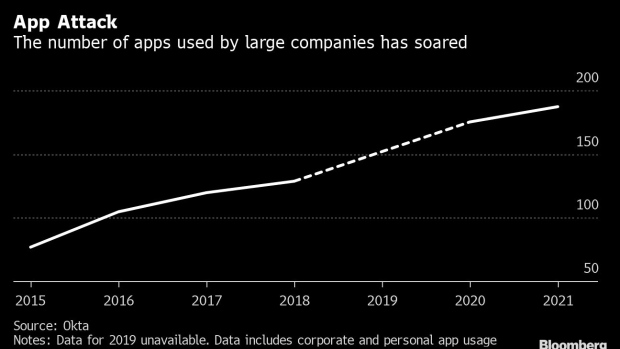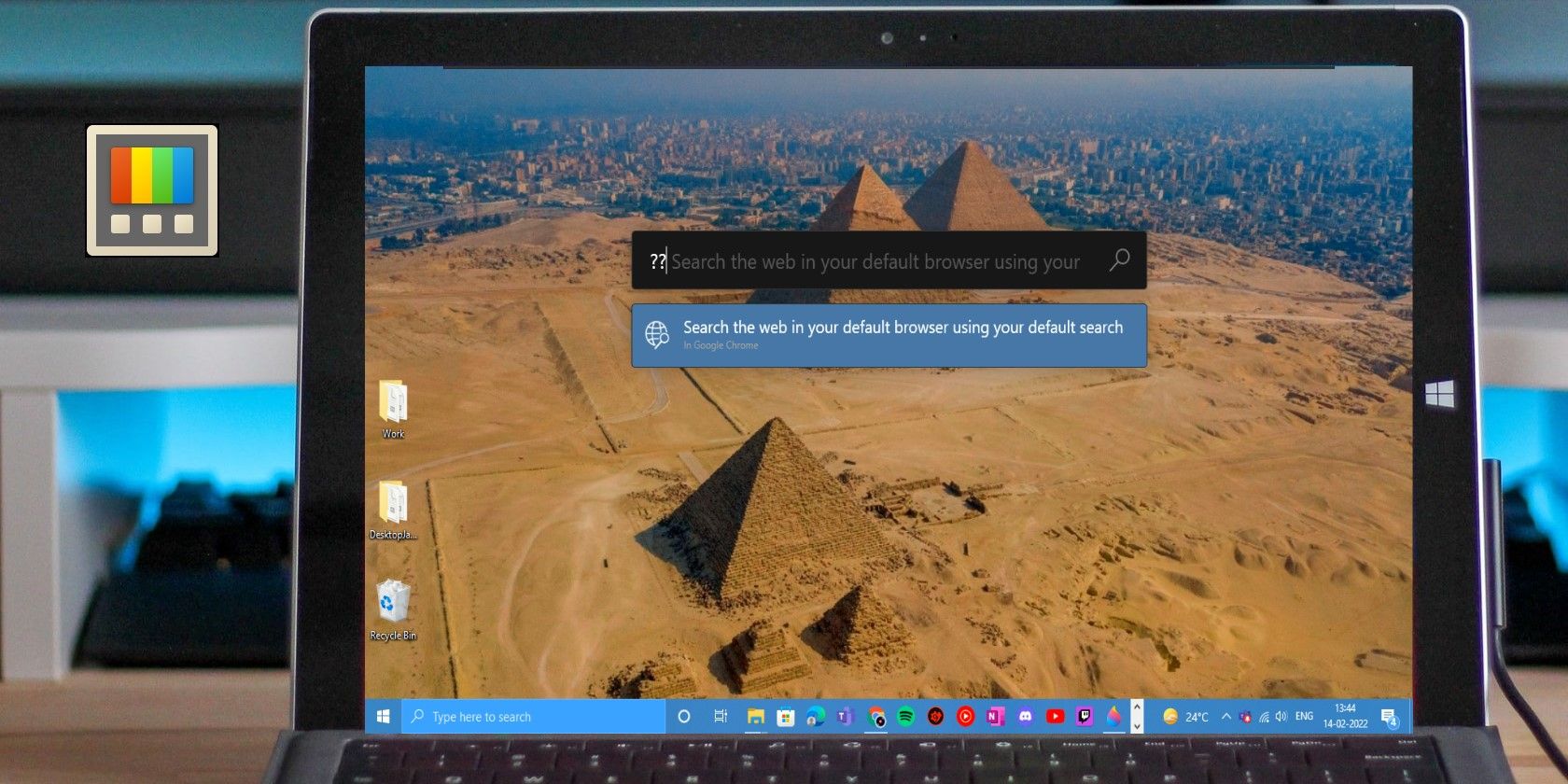(Bloomberg) —
Technological overload. computer swelling. Barnacle apps.
The problem goes by many names, but the story is the same: employees are overwhelmed by an ever-expanding array of specialized software that makes the workday a disjointed chore.
Workplace tools have never been popular – who likes filling out expense reports? — but when the pandemic hit, virtual communication and collaboration programs became essential for businesses. New employees were onboarded by one app, trained by another, and interviewed by a third.
As Covid-19 progressed, concerns about burnout and record dropout rates prompted companies to add wellness and recognition programs. Workers and rogue teams also brought their own favorite tools. Apps upon apps, all with relentless notifications, encrypted passwords and byzantine protocols. And unlike your uncle’s Facebook posts, they’re not easily muted.
How bad is that? Companies deployed 89 different applications on average last year, up from 58 in 2015, according to Okta, a cloud software company. Among large employers, the figure is now 187. Of these applications, nearly 30% are duplicated or add no value, according to a survey of senior business leaders by WalkMe, an enterprise software provider .
A recent study of 20 teams from three large employers found that workers switch between different apps and websites 1,200 times a day. That’s just under four hours a week, or about five weeks a year, spent hitting the Alt-Tab key. Researchers have dubbed it the “tipping tax,” but it’s better known to psychologists as context switching — a habit that makes it hard to focus and, over time, stresses us out.
“Fundamentally, the way we work is itself a distraction,” said Rohan Narayana Murty, founder and chief technology officer at Soroco, which uses machine learning to map how work is done, and led the failover study. “Throughout the day, we repeatedly switch between disparate apps.”
Technology-related frustrations at large companies prompted 76 employees, on average, to leave last year, according to WalkMe’s survey. “People only have a certain level of tolerance, and then they just check,” said Bob Ellis, global talent and organization practice leader at Infosys Consulting.
Scott Fingerhut, a longtime Silicon Valley marketing executive, has seen this firsthand over the years. “The hardest thing, he says, is that most people don’t see it coming. You do not receive a burnout notification. Application overload can strike any workplace. Natacha Arboleda is a hairstylist at Fox & Jane, a chain of a dozen salons, mostly in New York. The company uses one app to schedule appointments, another for stylists to chat with office staff, and a third for HR functions such as payroll and time off requests. To make matters worse, management has changed the HR application three times since Arboleda started there.
“If it ain’t broke, don’t fix it,” she said. Apps can take a long time, especially when she logs out of one, forgets her password, and has to ask a manager to help her get back in. Chat notifications are constant and especially annoying on his days off. But when she silences them, “I forget to turn them back on,” Arboleda said.
If a hair salon requires multiple apps, imagine a professional services business with dozens of clients, each with their own favorite programs that need to be mastered. Steve Dinelli, who runs a digital marketing agency in Chicago, says the overload problem has hurt his company’s productivity.
“There are always messages going back and forth internally asking where different things are for different customers. Is it in a google doc? E-mail? Drop box? Soft? It could be anywhere. And good luck weeding out the apps: “Clients will just find someone who works the way they want.”
Technology overload even influences office design, and not necessarily for the better. MillerKnoll Inc., the furniture giant behind the ubiquitous Aeron chair, has recently received more and more requests for workstations that support two monitors instead of one. More apps, more screens.
The changing nature of work after Covid-19 is not the only catalyst here. In the years before the pandemic, companies were switching from old-school mainframe software applications to cheaper cloud applications, also known as software as a service (SaaS). The $247 billion SaaS market is dominated by vendors such as Salesforce Inc., Oracle Corp., SAP SE, Google and Microsoft Corp., whose Teams video conferencing service now has more than 270 million active users, versus 20 million in 2019.
Cloud apps are easy to build, buy, and deploy, leading to what industry consultant Creative Strategies calls a “mix and match workflow.”
For example, employees may prefer to make their video calls on Zoom, whose market share has almost tripled since 2019. But during these calls, they also chat on Slack and share documents using Microsoft Teams, which is perfectly integrated with Word, PowerPoint and Excel. Some apps are only used by a few employees, while others are popular for a while and then get supplanted and disappear into the background – the so-called barnacle apps. (Remember Skype?) More than half of IT professionals surveyed by cloud software maker Freshworks Inc. say they pay for SaaS items that their IT teams never even use.
Tori Paulman sees this happen every day. As Senior Analyst Director of Gartner Inc.’s Employee Experience Technology Group, she is responsible for evaluating and recommending workplace software to clients that will make their jobs easier, not harder – which is calls in the consulting industry “human-centric IT strategies”. “But his direct assessment is that humans are barely at the periphery at the moment, let alone at the center.
“Technology,” she said, “has gone from great enabler to great inhibitor.” She tells horror stories where employees have to navigate through five different apps just to start their day. Or his favorite: an HR manager who said employees were getting tired of all these apps and asked if there was an app to fix it.
Don’t laugh: often the only way to make sense of all that technology is, you guessed it, to add more technology. Project management software vendors like Asana Inc., Atlassian Corp. and Monday.com promise their customers that using their platforms can improve efficiency and reduce application clutter, and they’ve won over customers like Seismic Software Inc., which dropped half a dozen programs. recently to consolidate its workflows with Monday. San Diego-based Seismic, which makes software that helps sales teams, said the move saves them time and money. But the company still uses separate apps to track its business goals, and yet another to conduct employee surveys.
“There is still a bit of overlap in our systems,” said Linda Ho, Seismic’s director of human resources. Worse, even Ho, a software industry executive, said she often doesn’t see much to tell one app from another. “At some point, they all start looking pretty much the same.”
Other business leaders have taken a snub at their proliferation of software. Prasad Ramakrishnan, chief information officer at Freshworks, said he had already had more than 800 apps in his 1,300-person company. He has now whittled it down to just over 200, and his goal is to reach 150 eventually. (The company now has more than 5,000 employees.) A quick fix: the legal, finance, and business departments each used different document management tools, and each had their own personal ID, which posed a huge risk to Security. Now they all use Box Inc. Four video conferencing apps have been reduced to one. Every few months, he meets with his IT and finance team and finds new programs to eliminate. “It’s not a one-time project,” he said.
Don’t shed a tear for these pruned sellers, though. They’re hard at work building brand new work apps, like Microsoft’s Viva, an employee-focused platform that handles things like staff surveys, learning, and goal tracking. Employees of Unilever Plc and PayPal Holdings Inc. are among its 10 million users, all hoping one more app will make a big difference.
A few startups are taking it a step further, trying to replace Google’s Chrome and other ad-supported web browsers. One of them, a Bay Area company called Sidekick, backed by venture capital titan Kleiner Perkins, is beta testing an enterprise-focused browser that allows workers to quickly switch between application to another and easily find any document or website. “Chrome will never evolve into something that’s designed for work – that’s why you have thousands of tabs open all day,” said CEO and co-founder Dmitry Pushkarev. “Our idea was to create a much better work environment that was not based on fatigue.”
Yet it is often unclear whether new approaches add to clutter or reduce it. “Everyone thinks that just buying a tool will help you solve a problem,” said Ho, the human resources chief. “This is all happening with the best of intentions.”
And that’s the crux of the matter, said Marketing Manager Fingerhut: “It’s death by 1,000 good intentions.”
©2022 Bloomberg LP




